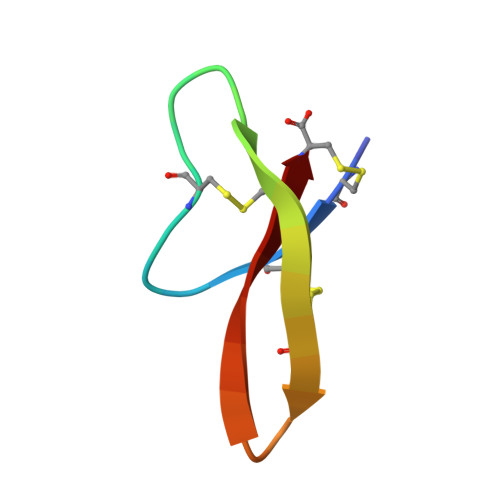Through the looking glass, mechanistic insights from enantiomeric human defensins.
Wei, G., de Leeuw, E., Pazgier, M., Yuan, W., Zou, G., Wang, J., Ericksen, B., Lu, W.Y., Lehrer, R.I., Lu, W.(2009) J Biological Chem 284: 29180-29192
- PubMed: 19640840
- DOI: https://doi.org/10.1074/jbc.M109.018085
- Primary Citation of Related Structures:
3GNY, 3GO0 - PubMed Abstract:
Despite the small size and conserved tertiary structure of defensins, little is known at a molecular level about the basis of their functional versatility. For insight into the mechanism(s) of defensin function, we prepared enantiomeric pairs of four human defensins, HNP1, HNP4, HD5, and HBD2, and studied their killing of bacteria, inhibition of anthrax lethal factor, and binding to HIV-1 gp120. Unstructured HNP1, HD5, and HBD3 and several other human alpha- and beta-defensins were also examined. Crystallographic analysis showed a plane of symmetry that related (L)HNP1 and (D)HNP1 to each other. Either d-enantiomerization or linearization significantly impaired the ability of HNP1 and HD5 to kill Staphylococcus aureus but not Escherichia coli. In contrast, (L)HNP4 and (D)HNP4 were equally bactericidal against both bacteria. d-Enantiomers were generally weaker inhibitors or binders of lethal factor and gp120 than their respective native, all-l forms, although activity differences were modest, particularly for HNP4. A strong correlation existed among these different functions. Our data indicate: (a) that HNP1 and HD5 kill E. coli by a process that is mechanistically distinct from their actions that kill S. aureus and (b) that chiral molecular recognition is not a stringent prerequisite for other functions of these defensins, including their ability to inhibit lethal factor and bind gp120 of HIV-1.
- Institute of Human Virology, University of Maryland School of Medicine, Baltimore, Maryland 21201, USA.
Organizational Affiliation:

















